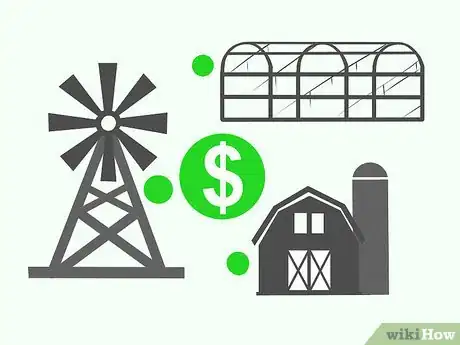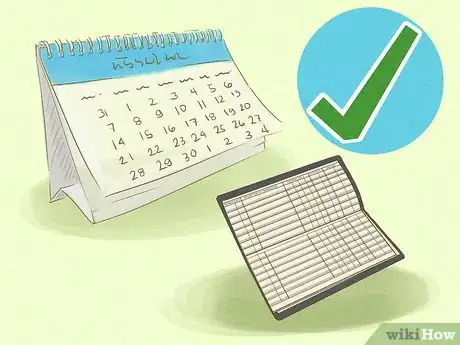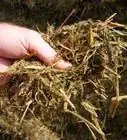This article was co-authored by wikiHow staff writer, Jennifer Mueller, JD. Jennifer Mueller is a wikiHow Content Creator. She specializes in reviewing, fact-checking, and evaluating wikiHow's content to ensure thoroughness and accuracy. Jennifer holds a JD from Indiana University Maurer School of Law in 2006.
There are 9 references cited in this article, which can be found at the bottom of the page.
This article has been viewed 26,172 times.
Learn more...
Small, family-owned farms make up the majority of the agricultural industry. At their core, these small farms are still businesses, and must be organized and run according to the same standards as any other small business. Spend time educating yourself on the agricultural industry and the demands of the occupation, and then you'll be ready to set up your farm and start growing.[1]
Steps
Building Your Resources
-
1Do market research. Just because you have a great idea in your head doesn't mean it will be profitable. Study the demand in your area so you know what crops or livestock people are most likely to buy.[2]
- Government agricultural departments collect statistics, and can be a good place for you to start. You also might want to look at information from university agricultural departments, as well as industry publications and websites. For example, the U.S. Department of Agriculture (USDA) has a wealth of information pages available free to beginning farmers on their website.
- Take distribution into consideration. During your first few years, you may not be able to invest in a distributor. Concentrate on demand locally or regionally rather than nationwide.
-
2Choose your crops or livestock. Your market research should give you an idea of what crops or livestock are in demand in your area. Whether you can grow those crops depends on a number of factors, such as where the farm is located and how large it is.[3]
- Evaluate the climate in the area and make sure it is generally conducive to growing the crops you've chosen.
- Once you start looking at actual farmland, you'll also want to pay attention to the soil quality and the growing history of the farm. Don't assume, for example, that you can grow corn just because there is corn growing at the farm across the street.
Advertisement -
3Contact regional farm groups and agricultural schools. The agricultural extension of your nearest agricultural school typically has extensive information and resources available for beginning farmers. Local farm groups can also provide you with assistance and connections.[4]
- Cooperative agricultural extensions in the U.S. also have a wealth of information on their websites. This can all be helpful, but is no substitute for going out there and getting your hands dirty.
-
4Visit your nearest farm services office. Most governments have a farm services agency or department, such as the U.S.'s Farm Service Agency (run by the USDA). These offices can provide you with technical assistance, advice on business and financial planning, and important information on local and regional agricultural developments.[5]
- The farm services office may have free financial and legal services that normally would cost you a lot of money.
- Take the time to introduce yourself to staff at the office and let them know that you are looking to start a small farm business in the area.
-
5Check state and local regulations. Understand the regulatory environment in the region where you want to operate your farm before you make any commitments to buy or lease land or farming equipment.[6]
- Look at zoning restrictions in particular. Some farming activities may be prohibited in particular areas, or may require expensive licensing and inspection.
- A regional farm group or farm services office can help you figure out what specific licenses or inspections you'll need to get up and running.
- Find out how long it takes to process the applications and how much the licensing fees cost so you can factor this into your overall business plan.
-
6Secure adequate land. If you don't already have land, look for available agricultural land in the general region where you want to operate your farm. Check zoning codes to make sure you will be able to raise the crops or livestock you want there.[7]
- Make sure the land has an adequate supply of water and is close to a larger body of water or effectively irrigated. Generally, you'll want at least 0.3 to 0.4 gallons (1.1 to 1.5 L) of water available per day for every square foot (0.09 square meters) of growing area.[8]
- Conduct soil quality tests and make sure the environment and conditions are hospitable for the crops or livestock you want to raise. You can do basic tests yourself, such as evaluating the color and texture of the soil. Test kits to check the Ph balance of the soil are relatively inexpensive and will give you additional information.
-
7Seek government assistance. Depending on where your farm is located and what crops or livestock you plan to produce, you may be eligible for government grants and loans. Many areas have grants for new organic farms in particular.[9]
- Nonprofit environmental organizations also may provide grants and other assistance for farmers who are running sustainable operations.
- Do a search online to find out what government agencies and nonprofit organizations operate in your area. You can also talk to local farmers to get an idea of other resources that might be available.
Setting up Your Business
-
1Draft a formal business plan. Especially if you're self-financing your small farm business, you may think a formal business plan isn't necessary. However, a formal business plan can help you start to think of your farm as a business and treat it seriously.[10]
- Rely on your market research to come up with profitability predictions. Keep in mind it typically takes small farms several years to get off the ground.
- If you plan on running your farm as a side-business or a hobby farm, a business plan can still help you organize the finances for your farm and keep it from taking over your personal funds.
-
2Go over your plans with an advisor. Once you've finished your business plan, have a business startup or financial advisor critique it and offer suggestions to improve. Look for someone who has extensive experience working with successful small farm businesses.[11]
- Check with a government farm services office or a regional farm group if you're having a hard time finding a good advisor. Staff at any of those locations typically can provide a strong local recommendation or two.
-
3Choose your small farm's business structure. When you're starting out, you have the choice to run your small farm business as a sole proprietorship, an LLC, or a corporation. The form you choose depends on your business goals and the level of personal risk you want to assume.[12]
- If you organize your business as a sole proprietorship, your farm is not separate from you and your personal finances in any way. This may be the easiest option if you're just running your farm as a side-business and have a full-time job.
- A corporation gives you the most personal protection, but also is the most expensive and time-consuming form. You can incorporate at any time, so wait until your farm starts turning a profit.
- An LLC, or limited liability company, provides all of the benefits of a corporation and a sole proprietorship with none of the downsides of either. Choose this form if your goal is to make your living from your farm someday.
-
4Get a tax ID number for your small farm business. Even if you don't hire any employees (although you probably will), you will need a separate tax ID number for your farm business so you can pay taxes on farm income.[13]
- If you're in the U.S., you can get an employer identification number (EIN) fairly easily. Simply answer a few questions about your business and you can get your EIN immediately. Write it down or print it out and keep it in a safe place.
- You may need a separate tax ID number for state or local taxes as well.
-
5Register your farm with farm services. If you haven't already made friends with staff at your nearest farm services office, now is the time to do so. Schedule an appointment to register your farm so you can take advantage of any government subsidies or benefits.[14]
- Bring property documents along with proof of personal identity and business organization documents.
- Once you're registered, make sure you report any changes in the ownership or organization of your business as soon as possible, and keep your contact information up to date. You may be required to file regular acreage reports and other documentation.
-
6Get all required licenses and permits. Depending on the crops or livestock you're raising, the state or local government may require regular inspections and licensing of your farm operations.[15]
- For example, if you're selling crops to the public, you may need a license certifying that your storage facilities meet local health code requirements. Your local town or county government office is one way to find out what licenses are needed. You can also talk to neighboring farmers and find out from them what you'll need.
- Your state university agricultural extension program typically has specific information and resources to help you handle any licenses or permits you need at either the local or state level.
Establishing Your Farm
-
1Assemble your management team. You probably aren't starting a farm all on your own. Typically you want at least two or three people to help you run the farm and establish policies and procedures to help the farm operate smoothly and efficiently.[16]
- Write out job descriptions and discuss development of the farm and any gaps in funding or equipment you still need. For example, you may have one person who is in charge of harvesting, one in charge of planting, and one in charge of the marketing and sales operations of your farm.
- You also want to establish farm safety policies, both for the people who work there and for any visitors you may have. For example, you may require specific training before anyone can operate large farm machinery, and prohibit anyone from operating farm machinery if they are under the influence of alcohol or particular drugs or medications.
-
2Set up all necessary insurance. Farming is a dangerous business, and there are a lot of risks involved. In addition to basic liability insurance, you may want to take out crop, revenue, and livestock insurance.[17]
- Crop insurance protects you and your farm in case a disaster affects your crops. It also guarantees a minimum income each year, based on the number of acres you've planted. Contact your local farm services office to find out what types of insurance are available and the locations of companies that offer them so you can shop around for rates.
- If you still need to get financing, having crop insurance can open the doors to more financing options. Your farm is a much more attractive investment when you have crop insurance because the lender knows you'll pay the money back.
-
3Secure any financing. If you don't have the funds to get your farm up and running, you have several options, including loans. The federal government typically doesn't offer grants to people starting a small farm, but there are subsidies and other assistance available.[18]
- Some of the money available depends on whether your farm is a hobby farm or whether you intend it to be profitable. There aren't as many loans available for hobby farms, and many government subsidies are only available to working farms.
-
4Hire farm labor. When it's time to harvest, you may need extra hands to help you pick and harvest your crops for the season. If you plan to hire full-time employees, you may need to brush up on wage and hour standards for employees, as well as tax-withholding requirements.[19]
- Bringing in day labor typically isn't as regulated as hiring regular full- or part-time employees, but you still need to check with your state government and make sure you're complying with any applicable minimum wage law, and with child labor and other laws.
-
5Set up your records and bookkeeping systems. If you want your farm to be profitable, you must keep meticulous daily and weekly records of farm and financial data, such as amounts of crops harvested and sold or the number of hours farmhands worked. You can keep records on paper by hand, or use accounting or record-keeping software.[20]
- Your local farm group or agriculture extension program may have classes on common accounting and record-keeping software.
- It doesn't matter what system you use as long as you use it. A computer app won't be better than a spiral-bound notebook if you never turn it on. Set aside at least 10 minutes a day to update your records.
-
6Develop promotions and marketing channels. Even when you're just starting, you still should be networking to find customers for your farm. Local restaurants can be a good place to start, and discounts to your first few customers will help get your farm moving.[21]
- For example, you might offer a discount if a customer refers someone else to your farm who ends up buying from you. Better yet, give the discount to both the new customer and the person who referred them.
- Set up pages on social media so you can talk to and interact with people and spread the word about your farm.
- You also may want to put ads in restaurant-industry trade publications or on trade websites.
References
- ↑ http://articles.bplans.com/how-to-start-a-farm-and-how-to-start-farming/
- ↑ http://articles.bplans.com/how-to-start-a-farm-and-how-to-start-farming/
- ↑ http://articles.bplans.com/how-to-start-a-farm-and-how-to-start-farming/
- ↑ http://www.beginningfarmers.org/planning-a-new-farm/
- ↑ https://newfarmers.usda.gov/first-steps
- ↑ https://extension.psu.edu/starting-a-new-agricultural-business
- ↑ http://articles.bplans.com/how-to-start-a-farm-and-how-to-start-farming/
- ↑ https://ag.umass.edu/greenhouse-floriculture/fact-sheets/sizing-greenhouse-water-system
- ↑ http://articles.bplans.com/how-to-start-a-farm-and-how-to-start-farming/
- ↑ http://smallfarms.cornell.edu/plan-your-farm/planning-funding-your-farm-business/
- ↑ https://newfarmers.usda.gov/sites/default/files/checklist_3.pdf
- ↑ http://smallfarms.cornell.edu/plan-your-farm/planning-funding-your-farm-business/
- ↑ https://newfarmers.usda.gov/first-steps
- ↑ https://newfarmers.usda.gov/first-steps
- ↑ https://extension.psu.edu/starting-a-new-agricultural-business
- ↑ https://newfarmers.usda.gov/sites/default/files/checklist_3.pdf
- ↑ http://www.ag-risk.org/NCISPUBS/LAIPPUB/2012/Guide_2013.pdf
- ↑ https://extension.psu.edu/starting-a-new-agricultural-business
- ↑ https://extension.psu.edu/starting-a-new-agricultural-business
- ↑ http://smallfarms.cornell.edu/plan-your-farm/achieving-or-improving-profitability/
- ↑ https://extension.psu.edu/starting-a-new-agricultural-business














































































